European Bison , or Bison
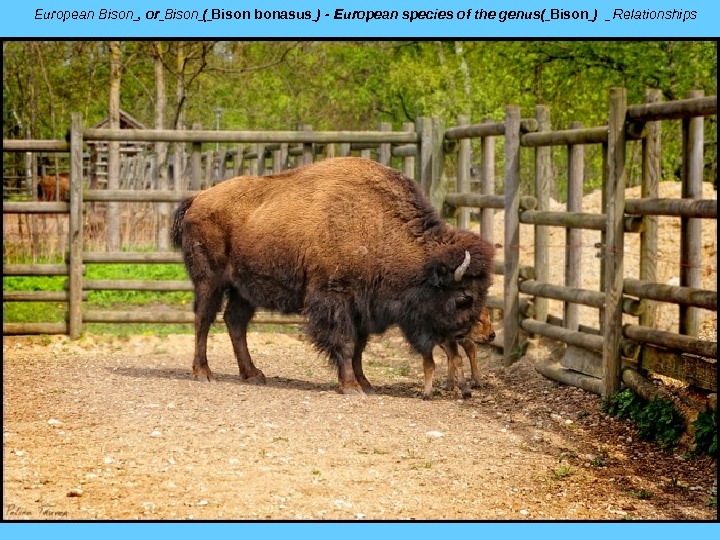
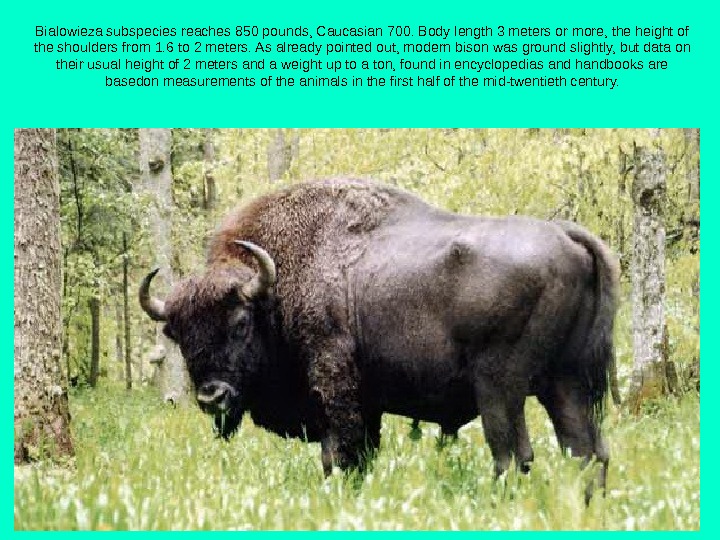

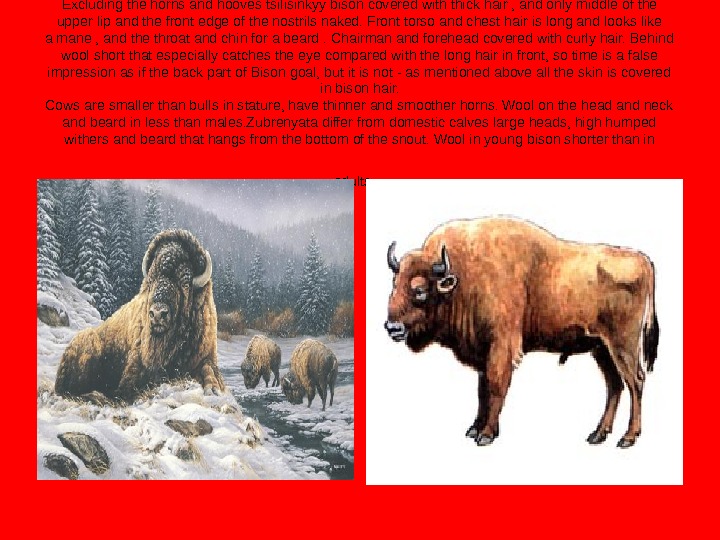
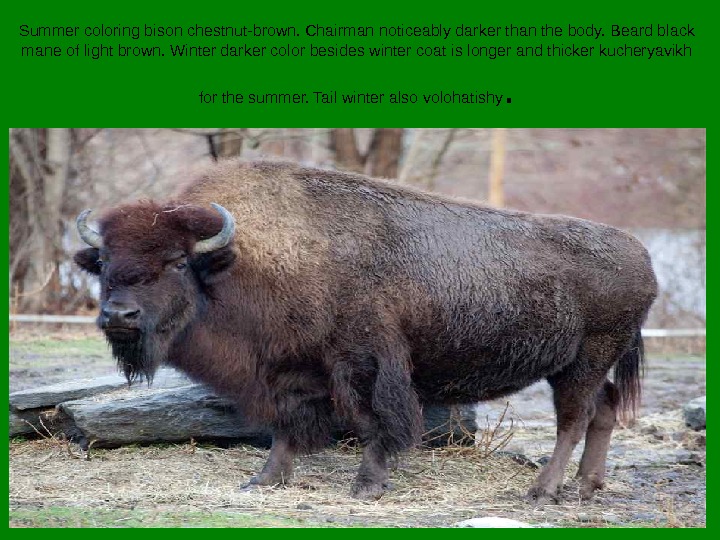



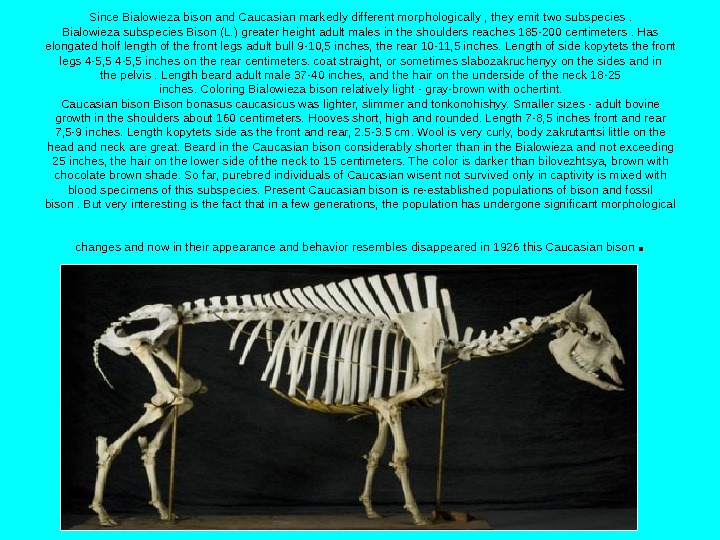
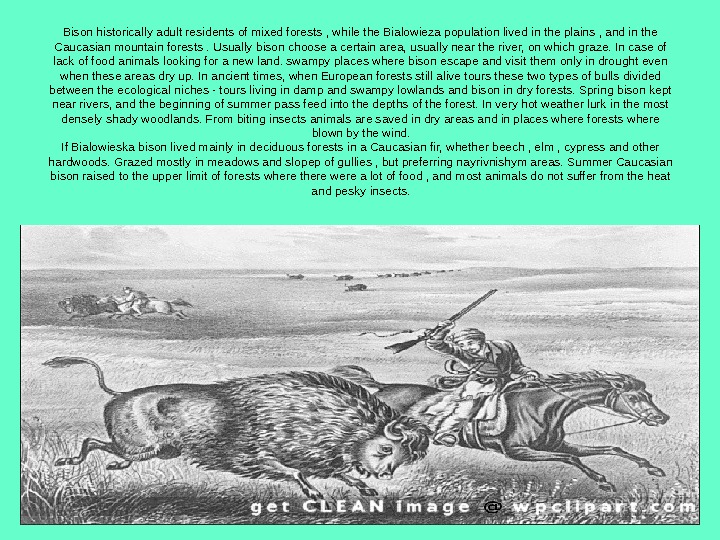
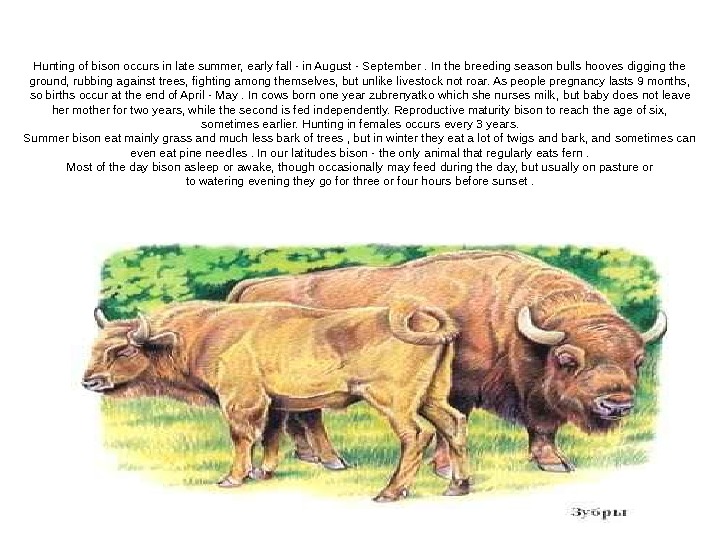


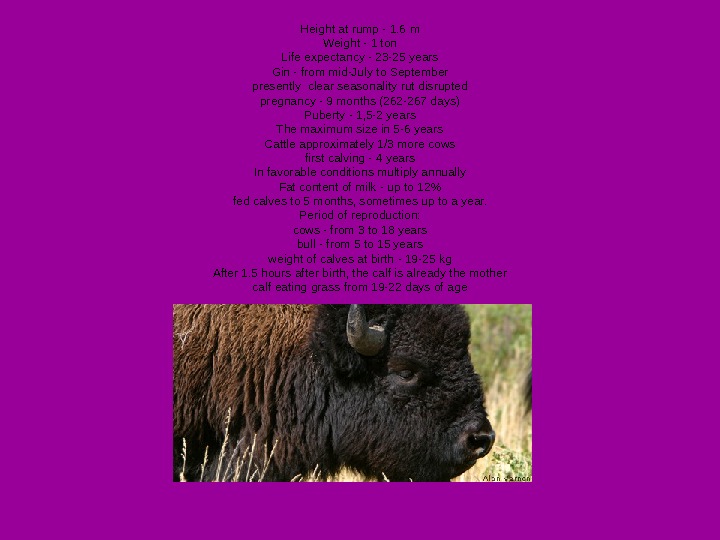
- Размер: 1.8 Mегабайта
- Количество слайдов: 14
Описание презентации European Bison , or Bison по слайдам
 European Bison , or Bison ( Bison bonasus )-Europeanspeciesofthegenus( Bison ) Relationships
European Bison , or Bison ( Bison bonasus )-Europeanspeciesofthegenus( Bison ) Relationships
 Bialowieza subspecies reaches 850 pounds, Caucasian 700. Body length 3 meters or more, the height of the shoulders from 1. 6 to 2 meters. As already pointed out, modern bison was ground slightly, but data on their usual height of 2 meters and a weight up to a ton, found in encyclopedias and handbooks are basedon measurements of the animals in the first half of the mid-twentieth century.
Bialowieza subspecies reaches 850 pounds, Caucasian 700. Body length 3 meters or more, the height of the shoulders from 1. 6 to 2 meters. As already pointed out, modern bison was ground slightly, but data on their usual height of 2 meters and a weight up to a ton, found in encyclopedias and handbooks are basedon measurements of the animals in the first half of the mid-twentieth century.
 The front part of the body in bison is much better developed — it is much more massive, higher and wider than the back, withers and before the back seems hump. Abdomen selected and does not sag. Chairman massive animals, shortened with wide convexforehead , tilted down. Horns in bison and small black , rounded, convex curve directed outwards (to the sides), and the tips of the top. Ears are short and wide thickly overgrown with hair. eyes are small and widely spaced. Neck powerful, thick, without characteristic of many bulls dropped pidhrudku. legs in bison strong, thick, front and rear significantly shorter. Hooves large, convex, there is also a small side hooves that do not reach the ground ( rudiments ). tail bison in fairly short with thick hair tassel at the tip.
The front part of the body in bison is much better developed — it is much more massive, higher and wider than the back, withers and before the back seems hump. Abdomen selected and does not sag. Chairman massive animals, shortened with wide convexforehead , tilted down. Horns in bison and small black , rounded, convex curve directed outwards (to the sides), and the tips of the top. Ears are short and wide thickly overgrown with hair. eyes are small and widely spaced. Neck powerful, thick, without characteristic of many bulls dropped pidhrudku. legs in bison strong, thick, front and rear significantly shorter. Hooves large, convex, there is also a small side hooves that do not reach the ground ( rudiments ). tail bison in fairly short with thick hair tassel at the tip.
 Excluding the horns and hooves tsilisinkyy bison covered with thick hair , and only middle of the upper lip and the front edge of the nostrils naked. Front torso and chest hair is long and looks like a mane , and the throat and chin for a beard. Chairman and forehead covered with curly hair. Behind wool short that especially catches the eye compared with the long hair in front, so time is a false impression as if the back part of Bison goal, but it is not — as mentioned above all the skin is covered in bison hair. Cows are smaller than bulls in stature, have thinner and smoother horns. Wool on the head and neck and beard in less than males. Zubrenyata differ from domestic calves large heads, high humped withers and beard that hangs from the bottom of the snout. Wool in young bison shorter than in adults.
Excluding the horns and hooves tsilisinkyy bison covered with thick hair , and only middle of the upper lip and the front edge of the nostrils naked. Front torso and chest hair is long and looks like a mane , and the throat and chin for a beard. Chairman and forehead covered with curly hair. Behind wool short that especially catches the eye compared with the long hair in front, so time is a false impression as if the back part of Bison goal, but it is not — as mentioned above all the skin is covered in bison hair. Cows are smaller than bulls in stature, have thinner and smoother horns. Wool on the head and neck and beard in less than males. Zubrenyata differ from domestic calves large heads, high humped withers and beard that hangs from the bottom of the snout. Wool in young bison shorter than in adults.
 Summer coloring bison chestnut-brown. Chairman noticeably darker than the body. Beard black mane of light brown. Winter darker color besides winter coat is longer and thicker kucheryavikh for the summer. Tail winter also volohatishy.
Summer coloring bison chestnut-brown. Chairman noticeably darker than the body. Beard black mane of light brown. Winter darker color besides winter coat is longer and thicker kucheryavikh for the summer. Tail winter also volohatishy.
 Spring molt occurs in mid-May and June, and by June the old wool climbs so that bison from a distance seem naked. In September hair short but undercoat so thick that after it is no longer visible skin. By winter coat extends, especially in front of the body and on their heads were males. Wool on the shoulder bison sticking up through the animals seem to be even higher. The presence of bison in a particular location can be defined by their tracks and droppings , as well as eaten ferns . Neither the Eastern forests or on the Caucasus is no other animal that would eat ferns. Litter bison is similar to mad cow.
Spring molt occurs in mid-May and June, and by June the old wool climbs so that bison from a distance seem naked. In September hair short but undercoat so thick that after it is no longer visible skin. By winter coat extends, especially in front of the body and on their heads were males. Wool on the shoulder bison sticking up through the animals seem to be even higher. The presence of bison in a particular location can be defined by their tracks and droppings , as well as eaten ferns . Neither the Eastern forests or on the Caucasus is no other animal that would eat ferns. Litter bison is similar to mad cow.
 Modern distribution bison Was common in ancient times, in the forests of Europe, Ukraine has disappeared in XVI — XVII centuries. According to the «Red Book of Ukraine» (2009) , «The historical range of the species from the Pyrenees to the West. Siberia, England South. Scandinavia.
Modern distribution bison Was common in ancient times, in the forests of Europe, Ukraine has disappeared in XVI — XVII centuries. According to the «Red Book of Ukraine» (2009) , «The historical range of the species from the Pyrenees to the West. Siberia, England South. Scandinavia.
 Was common in ancient times, in the forests of Europe, Ukraine has disappeared in XVI — XVII centuries. According to the «Red Book of Ukraine» (2009) [1] , «The historical range of the species from the Pyrenees to the West. Siberia, England South. Scandinavia. Bison given the size was very convenient and beneficial object hunt so late XIX early XX century survived only two natural populations — in the Bialowieza Forest and the North Caucasus in the upper reaches of the rivers Elbe and White. Bialowieza Forest in the end of XIX century lived until 1700 goals — on the one hand with the other animals guarding regularly arranged royal hunt. It is for the purpose of hunting while bison also brought to the Crimea and in Gatchina. Active hunting reduced the Bialowieza population to 737 individuals in 1914. War and the associated poaching led to a catastrophic reduction in livestock. In 1917, in Forest have only 168 bison, and in 1918 only 76. Some of the animals were ken to Germany. In February 1919, he was killed last free Bialowieza bison. Around the same time killing small population in the Crimea and Gatchina. As a result of the civil war ended protection of bison and the Caucasus. Brakon’yery destroyed the main population until 1924, in 1926 saw the last species. Caucasian subspecies of bison were killed. This large and beautiful animal as bison attracted attention, so the idea of reviving these animals. In 1923 came the International Society for the Protection of bison. There wererecords of all bison that pozalyshalysya back in zoos in the world — found 53 specimens. By 1938, the number of bison increased to 97 — 43 bulls and 54 cows, and only one bison was born in the wild in 1913 in Bilovezhskiy Forest. Bison was one of the first species which survived in zoos after the destruction of nature. Great effort on bison caused World War II , which killed about half of all cattle and only thereafter the number of bison began to grow. First bison fired at will in the Bialowieza Forest in both Polish and in Belarusian (then. Soviet) part. Later, with increasing number of bison released in other areas. In general we can say that the Bialowieza bison subspecies was rescued. A different fate Caucasian subspecies. Blooded Caucasian bison after destruction of the natural population has survived. However, in some zoos are animals mixed with blood Caucasian bison — Bialowieza bison hybrids or American buffalo. In 1940 work began to restore the Caucasian bison method of breeding and selection by absorbing crossing. Animals were killed during World War II, so the original subspecies Caucasian bison was lost. However, in the second half of the twentieth century, it was decided to restore the Caucasian population — was established herd of bison and fossil bison are released in some reserves on the North Caucasus. Oddly, but with time, just a few generations of these animals, in which there was virtually no blood Caucasian bison were greatly resemble subspecies that once lived here. They significantly changed morphologically even more changed their behavior. Therefore, although by modern Caucasian origin population of bison is not historical heir but morphologically and behaviorally similar to it. In Ukraine at the beginning of the 1990 s, kept 10 populations in Volyn, Kyiv, Chernihiv, Sumy, Lviv, Ivano-Frankivsk, Chernivtsi, Vinnytsia region. «. Although the species has the status of «Missing in nature, » according to the same publication goes that «There bison preserved everywhere except in the Chernihiv region. «. The population was reproduced from animals that survived the first half of the twentieth century. in zoological parks and private lands. In Ukraine kind accommodated, starting from 1965 in 1988 in Ukraine there will about 440 individuals: in Volyn, Kyiv, Chernihiv, Sumy, Lviv, Ivano-Frankivsk, Chernivtsi, Vinnytsia region. Located in the woods with clearings, meadows and marshes. Keeps small herds — up to 50 individuals.
Was common in ancient times, in the forests of Europe, Ukraine has disappeared in XVI — XVII centuries. According to the «Red Book of Ukraine» (2009) [1] , «The historical range of the species from the Pyrenees to the West. Siberia, England South. Scandinavia. Bison given the size was very convenient and beneficial object hunt so late XIX early XX century survived only two natural populations — in the Bialowieza Forest and the North Caucasus in the upper reaches of the rivers Elbe and White. Bialowieza Forest in the end of XIX century lived until 1700 goals — on the one hand with the other animals guarding regularly arranged royal hunt. It is for the purpose of hunting while bison also brought to the Crimea and in Gatchina. Active hunting reduced the Bialowieza population to 737 individuals in 1914. War and the associated poaching led to a catastrophic reduction in livestock. In 1917, in Forest have only 168 bison, and in 1918 only 76. Some of the animals were ken to Germany. In February 1919, he was killed last free Bialowieza bison. Around the same time killing small population in the Crimea and Gatchina. As a result of the civil war ended protection of bison and the Caucasus. Brakon’yery destroyed the main population until 1924, in 1926 saw the last species. Caucasian subspecies of bison were killed. This large and beautiful animal as bison attracted attention, so the idea of reviving these animals. In 1923 came the International Society for the Protection of bison. There wererecords of all bison that pozalyshalysya back in zoos in the world — found 53 specimens. By 1938, the number of bison increased to 97 — 43 bulls and 54 cows, and only one bison was born in the wild in 1913 in Bilovezhskiy Forest. Bison was one of the first species which survived in zoos after the destruction of nature. Great effort on bison caused World War II , which killed about half of all cattle and only thereafter the number of bison began to grow. First bison fired at will in the Bialowieza Forest in both Polish and in Belarusian (then. Soviet) part. Later, with increasing number of bison released in other areas. In general we can say that the Bialowieza bison subspecies was rescued. A different fate Caucasian subspecies. Blooded Caucasian bison after destruction of the natural population has survived. However, in some zoos are animals mixed with blood Caucasian bison — Bialowieza bison hybrids or American buffalo. In 1940 work began to restore the Caucasian bison method of breeding and selection by absorbing crossing. Animals were killed during World War II, so the original subspecies Caucasian bison was lost. However, in the second half of the twentieth century, it was decided to restore the Caucasian population — was established herd of bison and fossil bison are released in some reserves on the North Caucasus. Oddly, but with time, just a few generations of these animals, in which there was virtually no blood Caucasian bison were greatly resemble subspecies that once lived here. They significantly changed morphologically even more changed their behavior. Therefore, although by modern Caucasian origin population of bison is not historical heir but morphologically and behaviorally similar to it. In Ukraine at the beginning of the 1990 s, kept 10 populations in Volyn, Kyiv, Chernihiv, Sumy, Lviv, Ivano-Frankivsk, Chernivtsi, Vinnytsia region. «. Although the species has the status of «Missing in nature, » according to the same publication goes that «There bison preserved everywhere except in the Chernihiv region. «. The population was reproduced from animals that survived the first half of the twentieth century. in zoological parks and private lands. In Ukraine kind accommodated, starting from 1965 in 1988 in Ukraine there will about 440 individuals: in Volyn, Kyiv, Chernihiv, Sumy, Lviv, Ivano-Frankivsk, Chernivtsi, Vinnytsia region. Located in the woods with clearings, meadows and marshes. Keeps small herds — up to 50 individuals.
 Since Bialowieza bison and Caucasian markedly different morphologically , they emit two subspecies. Bialowieza subspecies Bison (L. ) greater height adult males in the shoulders reaches 185 -200 centimeters. Has elongated holf length of the front legs adult bull 9 -10, 5 inches, the rear 10 -11, 5 inches. Length of side kopytets the front legs 4 -5, 5 inches on the rear centimeters. coat straight, or sometimes slabozakruchenyy on the sides and in the pelvis. Length beard adult male 37 -40 inches, and the hair on the underside of the neck 18 -25 inches. Coloring Bialowieza bison relatively light — gray-brown with ochertint. Caucasian bison Bison bonasus caucasicus was lighter, slimmer and tonkonohishyy. Smaller sizes — adult bovine growth in the shoulders about 160 centimeters. Hooves short, high and rounded. Length 7 -8, 5 inches front and rear 7, 5 -9 inches. Length kopytets side as the front and rear, 2. 5 -3. 5 cm. Wool is very curly, body zakrutantsi little on the head and neck are great. Beard in the Caucasian bison considerably shorter than in the Bialowieza and not exceeding 25 inches, the hair on the lower side of the neck to 15 centimeters. The color is darker than bilovezhtsya, brown with chocolate brown shade. So far, purebred individuals of Caucasian wisent not survived only in captivity is mixed with blood specimens of this subspecies. Present Caucasian bison is re-established populations of bison and fossil bison. But very interesting is the fact that in a few generations, the population has undergone significant morphological changes and now in their appearance and behavior resembles disappeared in 1926 this Caucasian bison.
Since Bialowieza bison and Caucasian markedly different morphologically , they emit two subspecies. Bialowieza subspecies Bison (L. ) greater height adult males in the shoulders reaches 185 -200 centimeters. Has elongated holf length of the front legs adult bull 9 -10, 5 inches, the rear 10 -11, 5 inches. Length of side kopytets the front legs 4 -5, 5 inches on the rear centimeters. coat straight, or sometimes slabozakruchenyy on the sides and in the pelvis. Length beard adult male 37 -40 inches, and the hair on the underside of the neck 18 -25 inches. Coloring Bialowieza bison relatively light — gray-brown with ochertint. Caucasian bison Bison bonasus caucasicus was lighter, slimmer and tonkonohishyy. Smaller sizes — adult bovine growth in the shoulders about 160 centimeters. Hooves short, high and rounded. Length 7 -8, 5 inches front and rear 7, 5 -9 inches. Length kopytets side as the front and rear, 2. 5 -3. 5 cm. Wool is very curly, body zakrutantsi little on the head and neck are great. Beard in the Caucasian bison considerably shorter than in the Bialowieza and not exceeding 25 inches, the hair on the lower side of the neck to 15 centimeters. The color is darker than bilovezhtsya, brown with chocolate brown shade. So far, purebred individuals of Caucasian wisent not survived only in captivity is mixed with blood specimens of this subspecies. Present Caucasian bison is re-established populations of bison and fossil bison. But very interesting is the fact that in a few generations, the population has undergone significant morphological changes and now in their appearance and behavior resembles disappeared in 1926 this Caucasian bison.
 Bison historically adult residents of mixed forests , while the Bialowieza population lived in the plains , and in the Caucasian mountain forests. Usually bison choose a certain area, usually near the river, on which graze. In case of lack of food animals looking for a new land. swampy places where bison escape and visit them only in drought even when these areas dry up. In ancient times, when European forests still alive tours these two types of bulls divided between the ecological niches — tours living in damp and swampy lowlands and bison in dry forests. Spring bison kept near rivers, and the beginning of summer pass feed into the depths of the forest. In very hot weather lurk in the most densely shady woodlands. From biting insects animals are saved in dry areas and in places where forests where blown by the wind. If Bialowieska bison lived mainly in deciduous forests in a Caucasian fir, whether beech , elm , cypress and other hardwoods. Grazed mostly in meadows and slopep of gullies , but preferring nayrivnishym areas. Summer Caucasian bison raised to the upper limit of forests where there were a lot of food , and most animals do not suffer from the heat and pesky insects.
Bison historically adult residents of mixed forests , while the Bialowieza population lived in the plains , and in the Caucasian mountain forests. Usually bison choose a certain area, usually near the river, on which graze. In case of lack of food animals looking for a new land. swampy places where bison escape and visit them only in drought even when these areas dry up. In ancient times, when European forests still alive tours these two types of bulls divided between the ecological niches — tours living in damp and swampy lowlands and bison in dry forests. Spring bison kept near rivers, and the beginning of summer pass feed into the depths of the forest. In very hot weather lurk in the most densely shady woodlands. From biting insects animals are saved in dry areas and in places where forests where blown by the wind. If Bialowieska bison lived mainly in deciduous forests in a Caucasian fir, whether beech , elm , cypress and other hardwoods. Grazed mostly in meadows and slopep of gullies , but preferring nayrivnishym areas. Summer Caucasian bison raised to the upper limit of forests where there were a lot of food , and most animals do not suffer from the heat and pesky insects.
 Hunting of bison occurs in late summer, early fall — in August — September. In the breeding season bulls hooves digging the ground, rubbing against trees, fighting among themselves, but unlike livestock not roar. As people pregnancy lasts 9 months, so births occur at the end of April — May. In cows born one year zubrenyatko which she nurses milk , but baby does not leave her mother for two years, while the second is fed independently. Reproductive maturity bison to reach the age of six, sometimes earlier. Hunting in females occurs every 3 years. Summer bison eat mainly grass and much less bark of trees , but in winter they eat a lot of twigs and bark, and sometimes can even eat pine needles. In our latitudes bison — the only animal that regularly eats fern. Most of the day bison asleep or awake, though occasionally may feed during the day, but usually on pasture or to watering evening they go for three or four hours before sunset.
Hunting of bison occurs in late summer, early fall — in August — September. In the breeding season bulls hooves digging the ground, rubbing against trees, fighting among themselves, but unlike livestock not roar. As people pregnancy lasts 9 months, so births occur at the end of April — May. In cows born one year zubrenyatko which she nurses milk , but baby does not leave her mother for two years, while the second is fed independently. Reproductive maturity bison to reach the age of six, sometimes earlier. Hunting in females occurs every 3 years. Summer bison eat mainly grass and much less bark of trees , but in winter they eat a lot of twigs and bark, and sometimes can even eat pine needles. In our latitudes bison — the only animal that regularly eats fern. Most of the day bison asleep or awake, though occasionally may feed during the day, but usually on pasture or to watering evening they go for three or four hours before sunset.
 Bison were brought to a state of species under threat of extinction due to excessive and uncontrolled fishing. In most countries, the disappearance of bison occurred during ages 17 -19, and finally species was donyschenyy in many places during the First World War. This situation called for measures to protect the species, inc. ban on hunting, measures to restore executed populations, the establishment of protected areas in places of settlement of these bulls.
Bison were brought to a state of species under threat of extinction due to excessive and uncontrolled fishing. In most countries, the disappearance of bison occurred during ages 17 -19, and finally species was donyschenyy in many places during the First World War. This situation called for measures to protect the species, inc. ban on hunting, measures to restore executed populations, the establishment of protected areas in places of settlement of these bulls.
 In Ukraine and neighboring countries do not survive beyond bison hunting economy and generally beyond the concern of hunting organizations and groups, and destroy them quickly poachers. A significant risk of poaching, great pricing on illegal hunting and heavy fines in case of shortage economy is not interested in participating in programs to conserve bison. Cases of poaching on bison in Ukraine almost never investigated, even though it is required and conservation organizations and zoologist . In recent years, many bison slaughtered under the guise of «selective shooting» [3] , which is practiced in Ukraine since 2001 and is not used for any other mammalian species. It was a very sophisticated form of poaching, when this occasion organized hunt for sanovytyh and wealthy individuals. Now this practice stopped.
In Ukraine and neighboring countries do not survive beyond bison hunting economy and generally beyond the concern of hunting organizations and groups, and destroy them quickly poachers. A significant risk of poaching, great pricing on illegal hunting and heavy fines in case of shortage economy is not interested in participating in programs to conserve bison. Cases of poaching on bison in Ukraine almost never investigated, even though it is required and conservation organizations and zoologist . In recent years, many bison slaughtered under the guise of «selective shooting» [3] , which is practiced in Ukraine since 2001 and is not used for any other mammalian species. It was a very sophisticated form of poaching, when this occasion organized hunt for sanovytyh and wealthy individuals. Now this practice stopped.
 Height at rump — 1. 6 m Weight — 1 ton Life expectancy — 23 -25 years Gin — from mid-July to September presently clear seasonality rut disrupted pregnancy — 9 months (262 -267 days) Puberty — 1, 5 -2 years The maximum size in 5 -6 years Cattle approximately 1/3 more cows first calving — 4 years In favorable conditions multiply annually Fat content of milk — up to 12% fed calves to 5 months, sometimes up to a year. Period of reproduction: cows — from 3 to 18 years bull — from 5 to 15 years weight of calves at birth — 19 -25 kg After 1. 5 hours after birth, the calf is already the mother calf eating grass from 19 -22 days of age
Height at rump — 1. 6 m Weight — 1 ton Life expectancy — 23 -25 years Gin — from mid-July to September presently clear seasonality rut disrupted pregnancy — 9 months (262 -267 days) Puberty — 1, 5 -2 years The maximum size in 5 -6 years Cattle approximately 1/3 more cows first calving — 4 years In favorable conditions multiply annually Fat content of milk — up to 12% fed calves to 5 months, sometimes up to a year. Period of reproduction: cows — from 3 to 18 years bull — from 5 to 15 years weight of calves at birth — 19 -25 kg After 1. 5 hours after birth, the calf is already the mother calf eating grass from 19 -22 days of age
